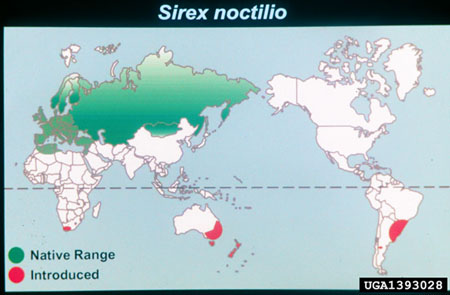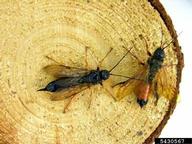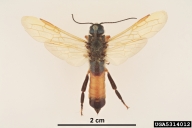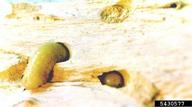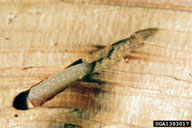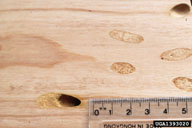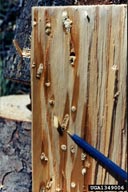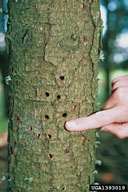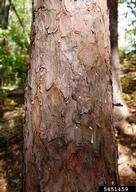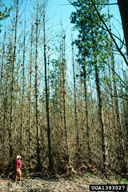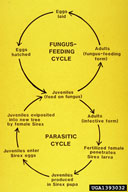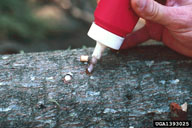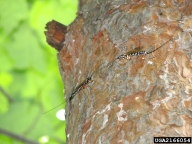Sirex woodwasp
Sirex noctilio (Fabricius) (Hymenoptera: Siricidae)
Orientation to pest
Sirex woodwasp, Sirex noctilio (Fabricius), is a European woodwasp that is widely invasive in the Southern Hemisphere. More recently it has also become established in the United States and Canada, with the initial discovery in New York in 2004. This species is a major threat to pines. In contrast to native North American woodwasps that attack only dead and dying trees, Sirex wood wasp can attack and kill living pines. At low population densities, the wasp selects suppressed, stressed, or injured trees for egg laying. Foliage of infested trees initially wilts and turns red in 3-6 months following attack. Infested trees often have pearly resin beads exuding from the drill holes where eggs were laid. Larval galleries are tightly packed with fine white sawdust and adults chew round exit holes that vary from 3 to 9 mm in diameter. Sirex noctilio is expected to complete one generation per year throughout most of the United States. Adult emergence occurs from July through September, with peak emergence during August. When eggs are laid, the female wasp also injects into the tree both a toxic mucus and a symbiotic fungus (Amylostereum areolatum [Fr.] Boidin). The toxic mucus shuts down the water transport, allowing the fungus to grow rapidly and kill the tree. The fungus also provides nutrition for the developing woodwasp larvae. Females can produce 25 to 450 eggs in their lifetime, depending upon their size. The larval stage generally takes 10-11 months.
Hosts commonly attacked
In addition to its preferred pine hosts (Pinus), S. noctilio can occasionally use spruce (Picea), fir (Abies), larch (Larix), and Douglas fir (Pseudotsuga menziesii Mirb.).
Distribution
Sirex noctilio is native to Eurasia and North Africa, but it has invaded the Southern Hemisphere (New Zealand, Australia, Argentina, Chile, Brazil, Uruguay, and South Africa). Most recently, it has also been introduced to the United States (Michigan, New York, Ohio, Pennsylvania, and Vermont) and Canada.
| Figure 1. Worldwide distribution of Sirex noctilio, before its invasion in North America |
Images of Sirex woodwasp
| Figure 2. Mating pair of Sirex woodwasps, Sirex noctilio (left photo: female left, male right) and, mounted adult male (right photo) | Figure 3. Larvae of Sirex noctilio in galleries inside wood | ||
| Figure 4. Wood sawn from a tree damaged by Sirex noctilio | Figure 5. Cambial staining caused by the symbiotic fungus (Amylostereum areolatum) that is transmitted by Sirex noctilio. White plugs are larval galleries packed with excrement (frass) | Figure 6. Emergence holes of Sirex noctilio. The round exit holes vary from 3 to 9 mm in diameter. | Figure 7. Resin beads from Sirex noctilio oviposition drills in red pine |
| Figure 8. Tree mortality (80-90%) from an outbreak in a 15-year old plantation in South Australia in 1989 | Figure 9. Life cycles of the two forms of the nematode Beddingia siricidicola. | Figure 10. Applying nematodes to an infested tree for biological control. Inoculation holes are made with a special punch hammer. | Figure 11. Sirex noctilio parasitoids, Rhyssa persuasoria (left) and Rhyssa lineolata (right). |
Important biological control agents related to this pest species
Several parasitoids have been introduced from Europe and North America into New Zealand and Australia for biological control of Sirex woodwasps in pine plantations. The most effective species were Rhyssa persuasoria (L.), Megarhyssa nortoni (Cresson), and Ibalia leucospoides Hochenwald. However, the highest level of control was ultimately provided in Australia by a parasitic nematode (Beddingia siricidicola [Bedding]). This nematode invades the eggs of female woodwasps and is transported by them to new egg laying sites. The growing nematode can develop into either of two very different forms: one is a fungus-eating form that lives on the symbiotic fungus transmitted by the woodwasp and the other is a parasite that develops inside woodwasp larvae and adults. Infected woodwasp larvae are not killed, but rather, the nematode reproduces inside the larval stages and infects the eggs of the adult female before she emerges from a tree. The nematode is effective in controlling Sirex woodwasp because it sterilizes the female but does not affect her flying ability, thus allowing her to disperse nematodes widely.
Web links for information on Sirex woodwasp
- Fact Sheet | Massachusetts Introduced Pests Outreach Project | MDAR and UMass Extension
- Species Profile | National Invasive Species Information Center | USDA National Agricultural Library
- Pest Alert Fact Sheet | USDA Forest Service, Northeastern Area
- Fact Sheet | USDA - APHIS CPHST
Articles
- Bedding, R. A. and E. T. Iede. 2005. Application of Beddingia siricidicola for Sirex woodwasp control, pp. 385-399. In: Nematodes as Biocontrol Agents. CAB International, Cambridge.
- Long, S. J., D. W. Williams, and A. E. Hajek. 2009. Sirex species (Hymenoptera: Siricidae) and their parasitoids in Pinus sylvestris in eastern North America. The Canadian Entomologist 14: 153-157.
- Dodds, K. J., P. de Groot, and D. A. Orwig. 2010. The impact of Sirex noctilio in Pinus resinosa and Pinus sylvestris stands in New York and Ontario. The Canadian Journal of Forest Research 40: 212-223.
- Slippers, B., P. DeGroot and M. J. Wingfield (eds.) The Sirex Woodwasp and its Fungal Symbiont ; Research and Management of a Worldwide Invasive Pest. Springer Pub. (in press)
- Schiff, N. M., H. Goulet, D. R. Smith, C. Boudreault, A. D. Wilson, and B. E. Scheffler. 2011. Siricidae (Hymenoptera: Siricoidea) of the Western Hemisphere. Canadian Journal of Arthropod Identification. In press
